Contemporary Memory Research: An Annotated Bibliography Analysis
VerifiedAdded on 2023/06/14
|11
|4304
|135
Annotated Bibliography
AI Summary
This annotated bibliography presents a compilation of five contemporary and credible sources discussing whether memory operates as a single function or comprises multiple distinct functions. The sources include studies on improving working memory in deaf children, the long-term effects of interference on short-term memory in rats, and the impact of language experience on non-verbal working memory in deaf children. Each annotation provides a summary of the study's methodology, findings, and implications, highlighting the strengths and weaknesses of each research approach. The bibliography emphasizes the complexity of memory processes and the diverse factors influencing memory performance across different populations and species. This resource is valuable for students seeking a deeper understanding of memory research and cognitive psychology, with more past papers and solved assignments available on Desklib.
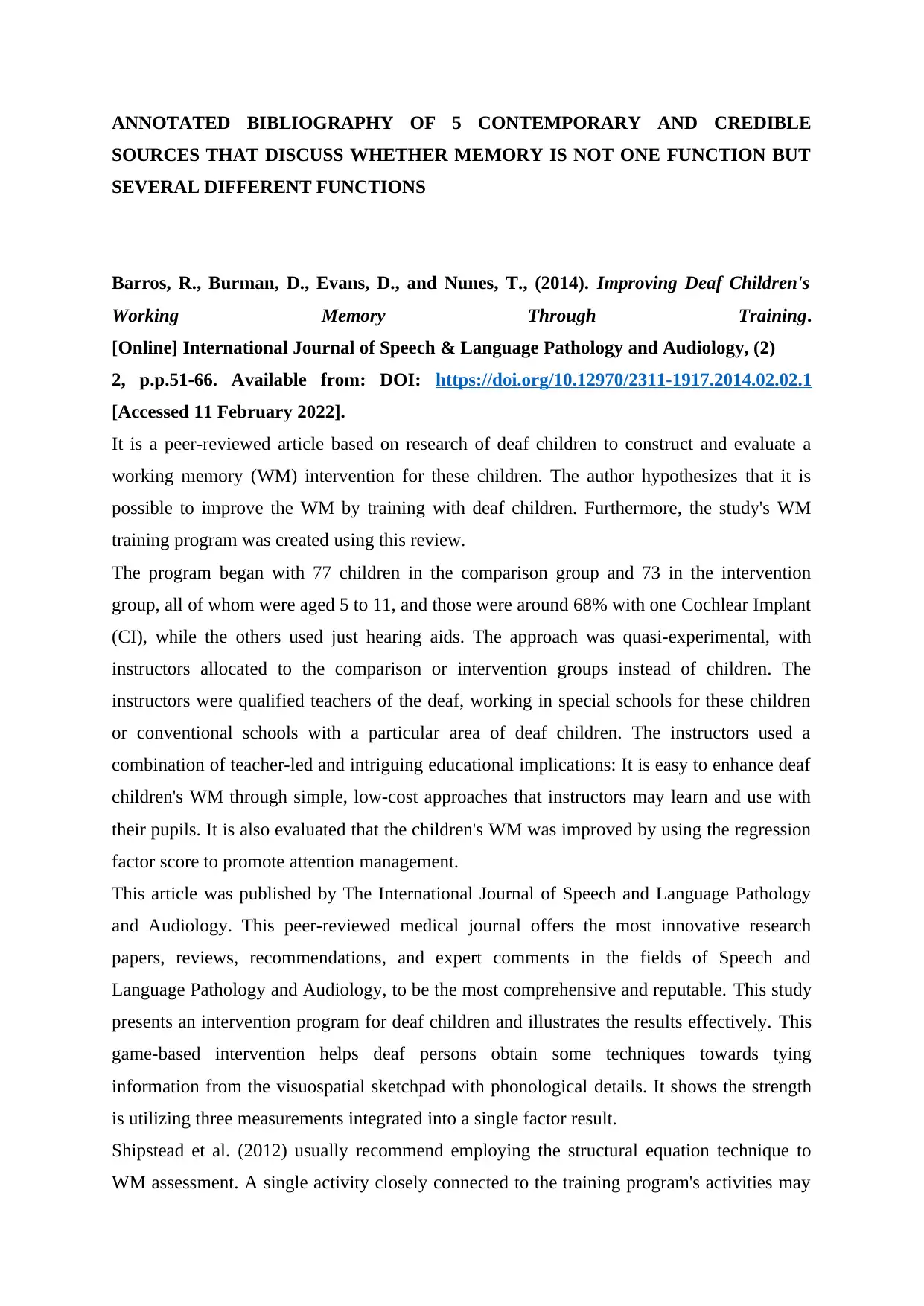
ANNOTATED BIBLIOGRAPHY OF 5 CONTEMPORARY AND CREDIBLE
SOURCES THAT DISCUSS WHETHER MEMORY IS NOT ONE FUNCTION BUT
SEVERAL DIFFERENT FUNCTIONS
Barros, R., Burman, D., Evans, D., and Nunes, T., (2014). Improving Deaf Children's
Working Memory Through Training.
[Online] International Journal of Speech & Language Pathology and Audiology, (2)
2, p.p.51-66. Available from: DOI: https://doi.org/10.12970/2311-1917.2014.02.02.1
[Accessed 11 February 2022].
It is a peer-reviewed article based on research of deaf children to construct and evaluate a
working memory (WM) intervention for these children. The author hypothesizes that it is
possible to improve the WM by training with deaf children. Furthermore, the study's WM
training program was created using this review.
The program began with 77 children in the comparison group and 73 in the intervention
group, all of whom were aged 5 to 11, and those were around 68% with one Cochlear Implant
(CI), while the others used just hearing aids. The approach was quasi-experimental, with
instructors allocated to the comparison or intervention groups instead of children. The
instructors were qualified teachers of the deaf, working in special schools for these children
or conventional schools with a particular area of deaf children. The instructors used a
combination of teacher-led and intriguing educational implications: It is easy to enhance deaf
children's WM through simple, low-cost approaches that instructors may learn and use with
their pupils. It is also evaluated that the children's WM was improved by using the regression
factor score to promote attention management.
This article was published by The International Journal of Speech and Language Pathology
and Audiology. This peer-reviewed medical journal offers the most innovative research
papers, reviews, recommendations, and expert comments in the fields of Speech and
Language Pathology and Audiology, to be the most comprehensive and reputable. This study
presents an intervention program for deaf children and illustrates the results effectively. This
game-based intervention helps deaf persons obtain some techniques towards tying
information from the visuospatial sketchpad with phonological details. It shows the strength
is utilizing three measurements integrated into a single factor result.
Shipstead et al. (2012) usually recommend employing the structural equation technique to
WM assessment. A single activity closely connected to the training program's activities may
SOURCES THAT DISCUSS WHETHER MEMORY IS NOT ONE FUNCTION BUT
SEVERAL DIFFERENT FUNCTIONS
Barros, R., Burman, D., Evans, D., and Nunes, T., (2014). Improving Deaf Children's
Working Memory Through Training.
[Online] International Journal of Speech & Language Pathology and Audiology, (2)
2, p.p.51-66. Available from: DOI: https://doi.org/10.12970/2311-1917.2014.02.02.1
[Accessed 11 February 2022].
It is a peer-reviewed article based on research of deaf children to construct and evaluate a
working memory (WM) intervention for these children. The author hypothesizes that it is
possible to improve the WM by training with deaf children. Furthermore, the study's WM
training program was created using this review.
The program began with 77 children in the comparison group and 73 in the intervention
group, all of whom were aged 5 to 11, and those were around 68% with one Cochlear Implant
(CI), while the others used just hearing aids. The approach was quasi-experimental, with
instructors allocated to the comparison or intervention groups instead of children. The
instructors were qualified teachers of the deaf, working in special schools for these children
or conventional schools with a particular area of deaf children. The instructors used a
combination of teacher-led and intriguing educational implications: It is easy to enhance deaf
children's WM through simple, low-cost approaches that instructors may learn and use with
their pupils. It is also evaluated that the children's WM was improved by using the regression
factor score to promote attention management.
This article was published by The International Journal of Speech and Language Pathology
and Audiology. This peer-reviewed medical journal offers the most innovative research
papers, reviews, recommendations, and expert comments in the fields of Speech and
Language Pathology and Audiology, to be the most comprehensive and reputable. This study
presents an intervention program for deaf children and illustrates the results effectively. This
game-based intervention helps deaf persons obtain some techniques towards tying
information from the visuospatial sketchpad with phonological details. It shows the strength
is utilizing three measurements integrated into a single factor result.
Shipstead et al. (2012) usually recommend employing the structural equation technique to
WM assessment. A single activity closely connected to the training program's activities may
Paraphrase This Document
Need a fresh take? Get an instant paraphrase of this document with our AI Paraphraser

improve this evaluation tool, especially if the training material and the post-test measure are
the same. Applications like this WM training program suffer from this limitation since they
try to enhance benefits by mixing elements that may not be useful alone. As Camos et al.
(2009) discovered that articulatory rehearsal and attention refreshing are two distinct
processes that impact WM information preservation; the current research cannot distinguish
between the roles of preparation and information bonding amongst sensory modalities to aid
recollection. However, additional study is required to determine if certain program features
are critical and whether the impacts of the various components are cumulative.
This study considered the use of other result's outcomes to compare with WM tasks in
hearing and deaf children's performance. It also develops likely answers in WM measures in
deaf children's weaker performance to improve and create a WM intervention program for
those children who learn visual and verbal rehearsal skills while practicing computer games.
The study's quasi-experimental methodology has a weakness that assigns instructors to the
intervention and comparison groups instead of children. Moreover, the study's design also
prevents an investigation of the transfer processes or the critical elements of enhancement
training. Among ethical considerations only specific to the parents' permission, only the
instructors were briefed on the approach employed and all research's specifics.
This academic research focuses on deaf children and how to improve their WM compared to
other studies within the annotation bibliography that focus on the difficulties. They have a
variety of tasks and a big group of children that is different from the other studies. The
research was peer-reviewed, which is complex to understand the results effectively.
In addition, various studies created understanding regarding hearing impairment that makes
difficulties in listening and develop issues for the quality of life and formulate hindrance in
day-to-day activities that individuals perform.
Camos V, Lagner P, Barrouillet P., 2009. Two Maintenance Mechanisms of Verbal
Information in Working Memory. Journal Memory and Language [online], 61 (3), 457-69.
Shipstead Z, Redick TS, Engle R.W., 2012. Is Working Memory Training Effective?
Psychological Bulletin [online], 138 (4), 628-54.
Fraize, N., Hamieh, A.M., Josehp, M.A., Malleret, G., Marighetto, A., Missaire, M.,
Parmentier, R. and Salin, P.A., (2017). Long-Term Effects of Interference on Short-
the same. Applications like this WM training program suffer from this limitation since they
try to enhance benefits by mixing elements that may not be useful alone. As Camos et al.
(2009) discovered that articulatory rehearsal and attention refreshing are two distinct
processes that impact WM information preservation; the current research cannot distinguish
between the roles of preparation and information bonding amongst sensory modalities to aid
recollection. However, additional study is required to determine if certain program features
are critical and whether the impacts of the various components are cumulative.
This study considered the use of other result's outcomes to compare with WM tasks in
hearing and deaf children's performance. It also develops likely answers in WM measures in
deaf children's weaker performance to improve and create a WM intervention program for
those children who learn visual and verbal rehearsal skills while practicing computer games.
The study's quasi-experimental methodology has a weakness that assigns instructors to the
intervention and comparison groups instead of children. Moreover, the study's design also
prevents an investigation of the transfer processes or the critical elements of enhancement
training. Among ethical considerations only specific to the parents' permission, only the
instructors were briefed on the approach employed and all research's specifics.
This academic research focuses on deaf children and how to improve their WM compared to
other studies within the annotation bibliography that focus on the difficulties. They have a
variety of tasks and a big group of children that is different from the other studies. The
research was peer-reviewed, which is complex to understand the results effectively.
In addition, various studies created understanding regarding hearing impairment that makes
difficulties in listening and develop issues for the quality of life and formulate hindrance in
day-to-day activities that individuals perform.
Camos V, Lagner P, Barrouillet P., 2009. Two Maintenance Mechanisms of Verbal
Information in Working Memory. Journal Memory and Language [online], 61 (3), 457-69.
Shipstead Z, Redick TS, Engle R.W., 2012. Is Working Memory Training Effective?
Psychological Bulletin [online], 138 (4), 628-54.
Fraize, N., Hamieh, A.M., Josehp, M.A., Malleret, G., Marighetto, A., Missaire, M.,
Parmentier, R. and Salin, P.A., (2017). Long-Term Effects of Interference on Short-
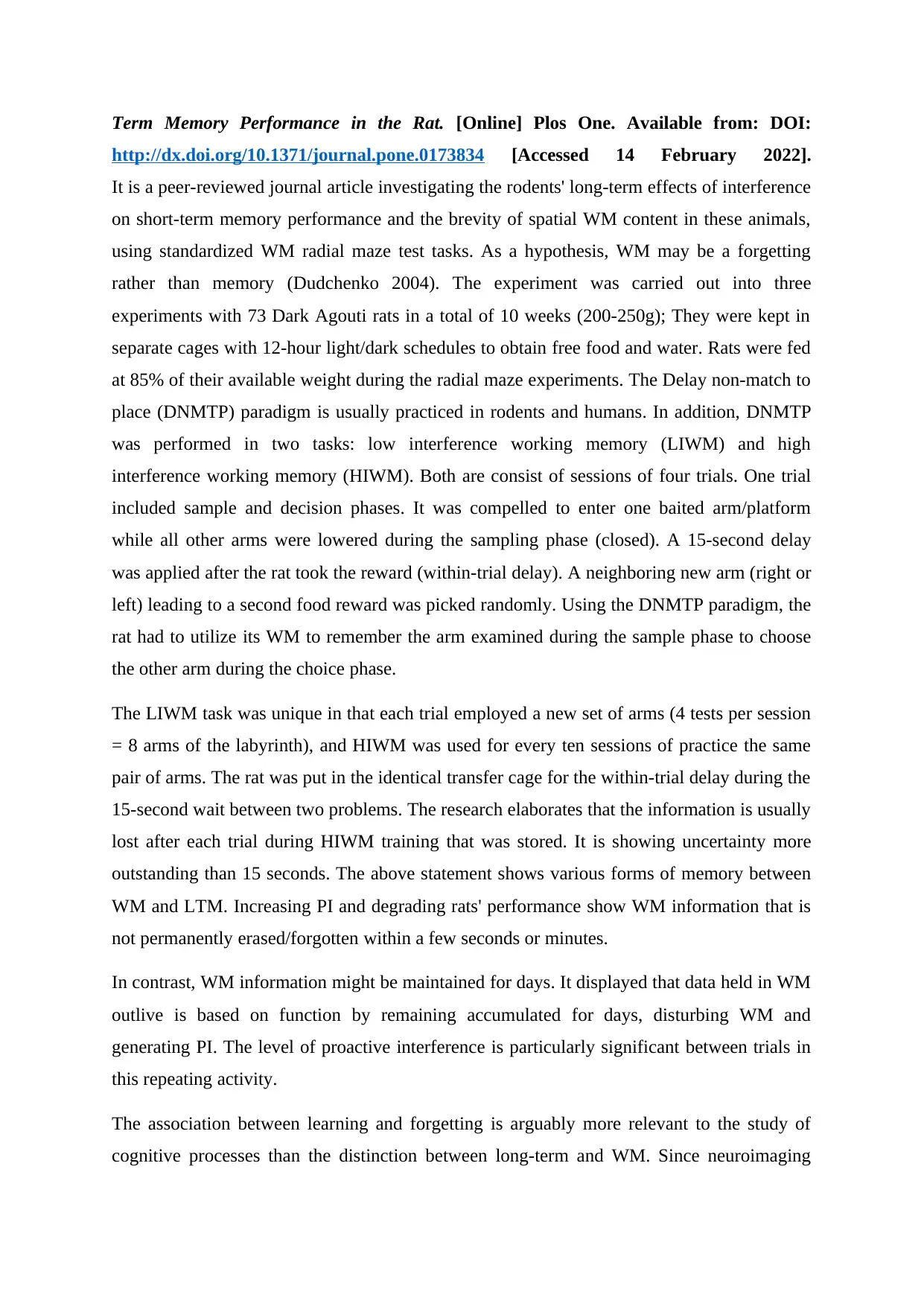
Term Memory Performance in the Rat. [Online] Plos One. Available from: DOI:
http://dx.doi.org/10.1371/journal.pone.0173834 [Accessed 14 February 2022].
It is a peer-reviewed journal article investigating the rodents' long-term effects of interference
on short-term memory performance and the brevity of spatial WM content in these animals,
using standardized WM radial maze test tasks. As a hypothesis, WM may be a forgetting
rather than memory (Dudchenko 2004). The experiment was carried out into three
experiments with 73 Dark Agouti rats in a total of 10 weeks (200-250g); They were kept in
separate cages with 12-hour light/dark schedules to obtain free food and water. Rats were fed
at 85% of their available weight during the radial maze experiments. The Delay non-match to
place (DNMTP) paradigm is usually practiced in rodents and humans. In addition, DNMTP
was performed in two tasks: low interference working memory (LIWM) and high
interference working memory (HIWM). Both are consist of sessions of four trials. One trial
included sample and decision phases. It was compelled to enter one baited arm/platform
while all other arms were lowered during the sampling phase (closed). A 15-second delay
was applied after the rat took the reward (within-trial delay). A neighboring new arm (right or
left) leading to a second food reward was picked randomly. Using the DNMTP paradigm, the
rat had to utilize its WM to remember the arm examined during the sample phase to choose
the other arm during the choice phase.
The LIWM task was unique in that each trial employed a new set of arms (4 tests per session
= 8 arms of the labyrinth), and HIWM was used for every ten sessions of practice the same
pair of arms. The rat was put in the identical transfer cage for the within-trial delay during the
15-second wait between two problems. The research elaborates that the information is usually
lost after each trial during HIWM training that was stored. It is showing uncertainty more
outstanding than 15 seconds. The above statement shows various forms of memory between
WM and LTM. Increasing PI and degrading rats' performance show WM information that is
not permanently erased/forgotten within a few seconds or minutes.
In contrast, WM information might be maintained for days. It displayed that data held in WM
outlive is based on function by remaining accumulated for days, disturbing WM and
generating PI. The level of proactive interference is particularly significant between trials in
this repeating activity.
The association between learning and forgetting is arguably more relevant to the study of
cognitive processes than the distinction between long-term and WM. Since neuroimaging
http://dx.doi.org/10.1371/journal.pone.0173834 [Accessed 14 February 2022].
It is a peer-reviewed journal article investigating the rodents' long-term effects of interference
on short-term memory performance and the brevity of spatial WM content in these animals,
using standardized WM radial maze test tasks. As a hypothesis, WM may be a forgetting
rather than memory (Dudchenko 2004). The experiment was carried out into three
experiments with 73 Dark Agouti rats in a total of 10 weeks (200-250g); They were kept in
separate cages with 12-hour light/dark schedules to obtain free food and water. Rats were fed
at 85% of their available weight during the radial maze experiments. The Delay non-match to
place (DNMTP) paradigm is usually practiced in rodents and humans. In addition, DNMTP
was performed in two tasks: low interference working memory (LIWM) and high
interference working memory (HIWM). Both are consist of sessions of four trials. One trial
included sample and decision phases. It was compelled to enter one baited arm/platform
while all other arms were lowered during the sampling phase (closed). A 15-second delay
was applied after the rat took the reward (within-trial delay). A neighboring new arm (right or
left) leading to a second food reward was picked randomly. Using the DNMTP paradigm, the
rat had to utilize its WM to remember the arm examined during the sample phase to choose
the other arm during the choice phase.
The LIWM task was unique in that each trial employed a new set of arms (4 tests per session
= 8 arms of the labyrinth), and HIWM was used for every ten sessions of practice the same
pair of arms. The rat was put in the identical transfer cage for the within-trial delay during the
15-second wait between two problems. The research elaborates that the information is usually
lost after each trial during HIWM training that was stored. It is showing uncertainty more
outstanding than 15 seconds. The above statement shows various forms of memory between
WM and LTM. Increasing PI and degrading rats' performance show WM information that is
not permanently erased/forgotten within a few seconds or minutes.
In contrast, WM information might be maintained for days. It displayed that data held in WM
outlive is based on function by remaining accumulated for days, disturbing WM and
generating PI. The level of proactive interference is particularly significant between trials in
this repeating activity.
The association between learning and forgetting is arguably more relevant to the study of
cognitive processes than the distinction between long-term and WM. Since neuroimaging
⊘ This is a preview!⊘
Do you want full access?
Subscribe today to unlock all pages.

Trusted by 1+ million students worldwide
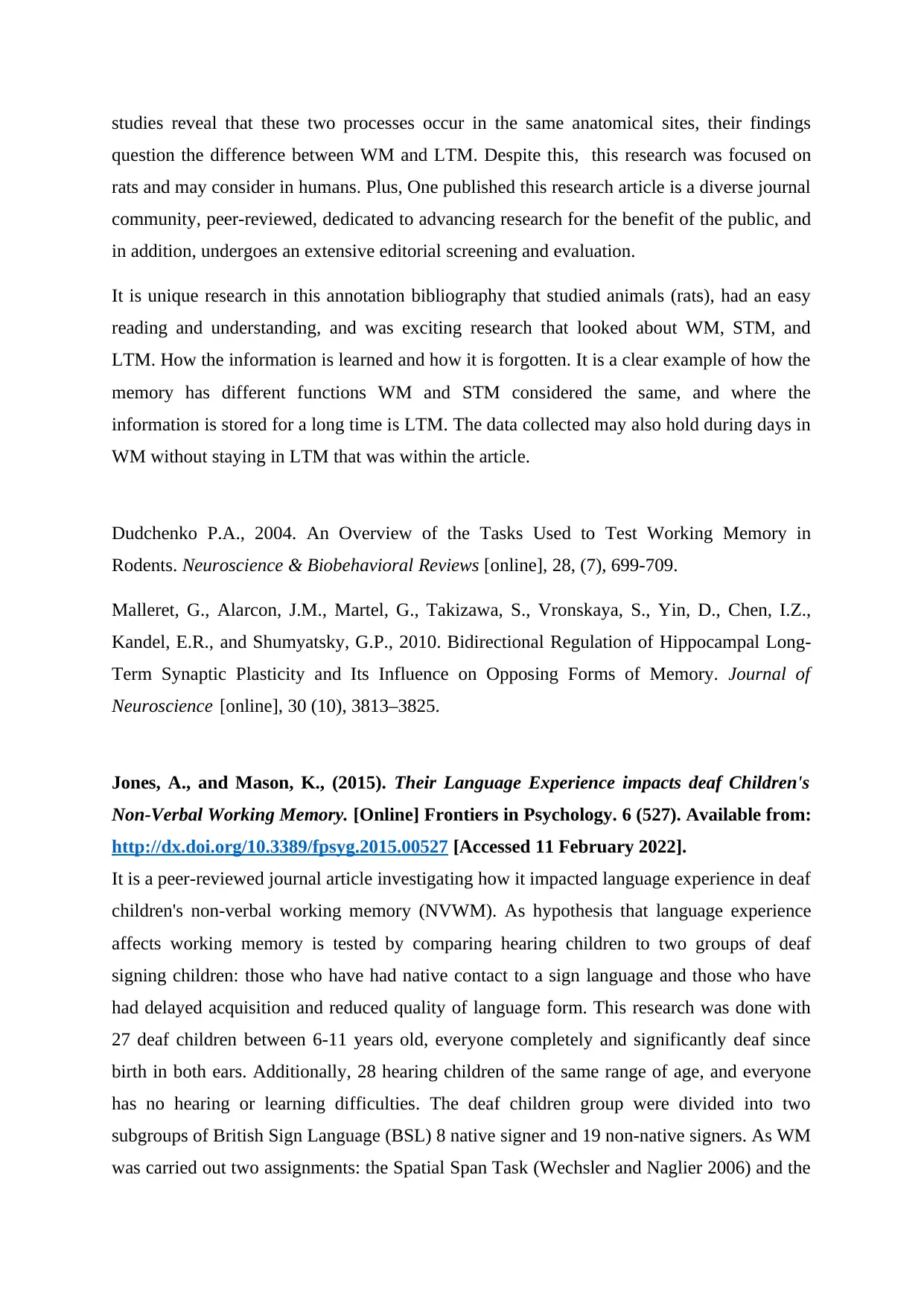
studies reveal that these two processes occur in the same anatomical sites, their findings
question the difference between WM and LTM. Despite this, this research was focused on
rats and may consider in humans. Plus, One published this research article is a diverse journal
community, peer-reviewed, dedicated to advancing research for the benefit of the public, and
in addition, undergoes an extensive editorial screening and evaluation.
It is unique research in this annotation bibliography that studied animals (rats), had an easy
reading and understanding, and was exciting research that looked about WM, STM, and
LTM. How the information is learned and how it is forgotten. It is a clear example of how the
memory has different functions WM and STM considered the same, and where the
information is stored for a long time is LTM. The data collected may also hold during days in
WM without staying in LTM that was within the article.
Dudchenko P.A., 2004. An Overview of the Tasks Used to Test Working Memory in
Rodents. Neuroscience & Biobehavioral Reviews [online], 28, (7), 699-709.
Malleret, G., Alarcon, J.M., Martel, G., Takizawa, S., Vronskaya, S., Yin, D., Chen, I.Z.,
Kandel, E.R., and Shumyatsky, G.P., 2010. Bidirectional Regulation of Hippocampal Long-
Term Synaptic Plasticity and Its Influence on Opposing Forms of Memory. Journal of
Neuroscience [online], 30 (10), 3813–3825.
Jones, A., and Mason, K., (2015). Their Language Experience impacts deaf Children's
Non-Verbal Working Memory. [Online] Frontiers in Psychology. 6 (527). Available from:
http://dx.doi.org/10.3389/fpsyg.2015.00527 [Accessed 11 February 2022].
It is a peer-reviewed journal article investigating how it impacted language experience in deaf
children's non-verbal working memory (NVWM). As hypothesis that language experience
affects working memory is tested by comparing hearing children to two groups of deaf
signing children: those who have had native contact to a sign language and those who have
had delayed acquisition and reduced quality of language form. This research was done with
27 deaf children between 6-11 years old, everyone completely and significantly deaf since
birth in both ears. Additionally, 28 hearing children of the same range of age, and everyone
has no hearing or learning difficulties. The deaf children group were divided into two
subgroups of British Sign Language (BSL) 8 native signer and 19 non-native signers. As WM
was carried out two assignments: the Spatial Span Task (Wechsler and Naglier 2006) and the
question the difference between WM and LTM. Despite this, this research was focused on
rats and may consider in humans. Plus, One published this research article is a diverse journal
community, peer-reviewed, dedicated to advancing research for the benefit of the public, and
in addition, undergoes an extensive editorial screening and evaluation.
It is unique research in this annotation bibliography that studied animals (rats), had an easy
reading and understanding, and was exciting research that looked about WM, STM, and
LTM. How the information is learned and how it is forgotten. It is a clear example of how the
memory has different functions WM and STM considered the same, and where the
information is stored for a long time is LTM. The data collected may also hold during days in
WM without staying in LTM that was within the article.
Dudchenko P.A., 2004. An Overview of the Tasks Used to Test Working Memory in
Rodents. Neuroscience & Biobehavioral Reviews [online], 28, (7), 699-709.
Malleret, G., Alarcon, J.M., Martel, G., Takizawa, S., Vronskaya, S., Yin, D., Chen, I.Z.,
Kandel, E.R., and Shumyatsky, G.P., 2010. Bidirectional Regulation of Hippocampal Long-
Term Synaptic Plasticity and Its Influence on Opposing Forms of Memory. Journal of
Neuroscience [online], 30 (10), 3813–3825.
Jones, A., and Mason, K., (2015). Their Language Experience impacts deaf Children's
Non-Verbal Working Memory. [Online] Frontiers in Psychology. 6 (527). Available from:
http://dx.doi.org/10.3389/fpsyg.2015.00527 [Accessed 11 February 2022].
It is a peer-reviewed journal article investigating how it impacted language experience in deaf
children's non-verbal working memory (NVWM). As hypothesis that language experience
affects working memory is tested by comparing hearing children to two groups of deaf
signing children: those who have had native contact to a sign language and those who have
had delayed acquisition and reduced quality of language form. This research was done with
27 deaf children between 6-11 years old, everyone completely and significantly deaf since
birth in both ears. Additionally, 28 hearing children of the same range of age, and everyone
has no hearing or learning difficulties. The deaf children group were divided into two
subgroups of British Sign Language (BSL) 8 native signer and 19 non-native signers. As WM
was carried out two assignments: the Spatial Span Task (Wechsler and Naglier 2006) and the
Paraphrase This Document
Need a fresh take? Get an instant paraphrase of this document with our AI Paraphraser
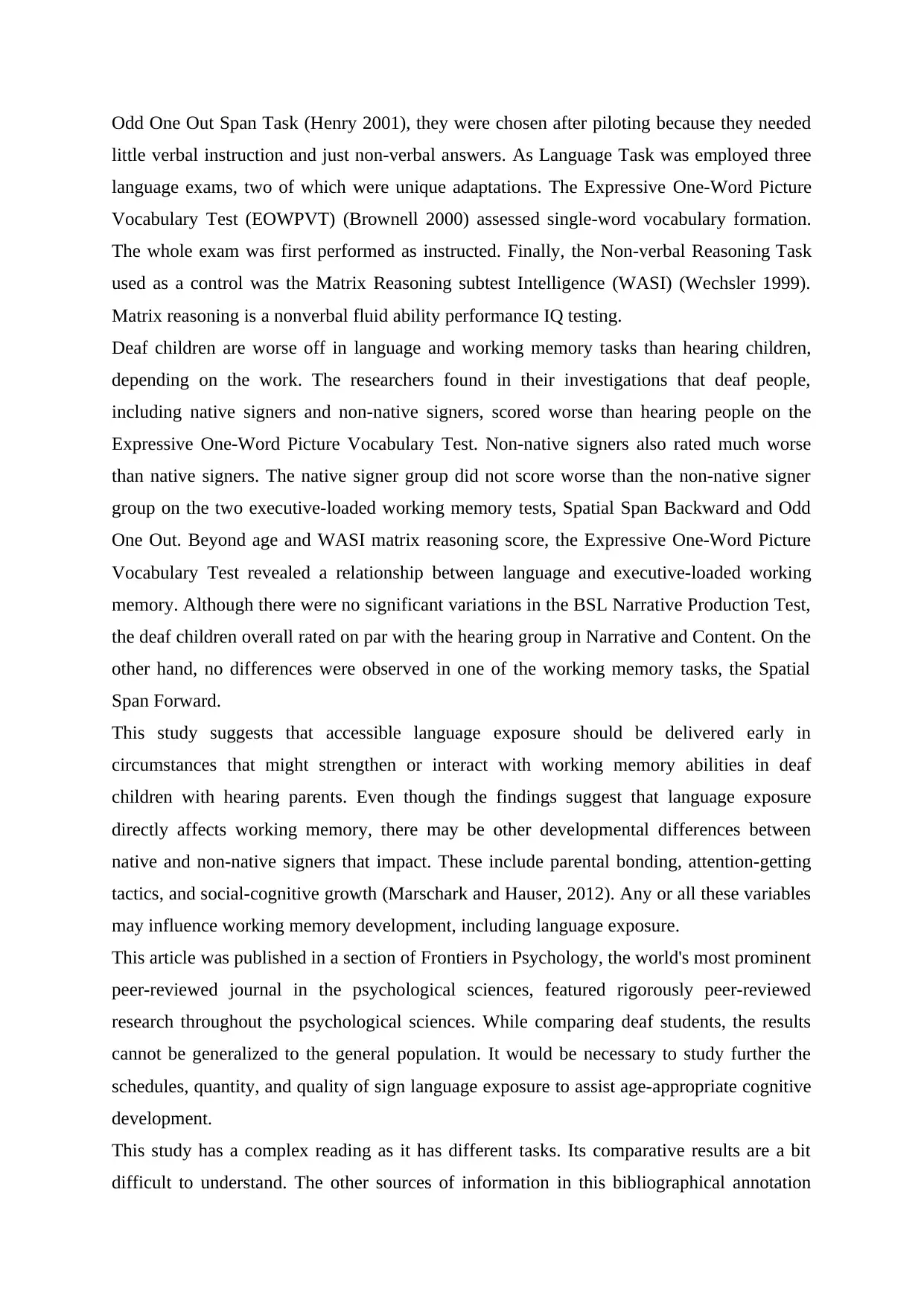
Odd One Out Span Task (Henry 2001), they were chosen after piloting because they needed
little verbal instruction and just non-verbal answers. As Language Task was employed three
language exams, two of which were unique adaptations. The Expressive One-Word Picture
Vocabulary Test (EOWPVT) (Brownell 2000) assessed single-word vocabulary formation.
The whole exam was first performed as instructed. Finally, the Non-verbal Reasoning Task
used as a control was the Matrix Reasoning subtest Intelligence (WASI) (Wechsler 1999).
Matrix reasoning is a nonverbal fluid ability performance IQ testing.
Deaf children are worse off in language and working memory tasks than hearing children,
depending on the work. The researchers found in their investigations that deaf people,
including native signers and non-native signers, scored worse than hearing people on the
Expressive One-Word Picture Vocabulary Test. Non-native signers also rated much worse
than native signers. The native signer group did not score worse than the non-native signer
group on the two executive-loaded working memory tests, Spatial Span Backward and Odd
One Out. Beyond age and WASI matrix reasoning score, the Expressive One-Word Picture
Vocabulary Test revealed a relationship between language and executive-loaded working
memory. Although there were no significant variations in the BSL Narrative Production Test,
the deaf children overall rated on par with the hearing group in Narrative and Content. On the
other hand, no differences were observed in one of the working memory tasks, the Spatial
Span Forward.
This study suggests that accessible language exposure should be delivered early in
circumstances that might strengthen or interact with working memory abilities in deaf
children with hearing parents. Even though the findings suggest that language exposure
directly affects working memory, there may be other developmental differences between
native and non-native signers that impact. These include parental bonding, attention-getting
tactics, and social-cognitive growth (Marschark and Hauser, 2012). Any or all these variables
may influence working memory development, including language exposure.
This article was published in a section of Frontiers in Psychology, the world's most prominent
peer-reviewed journal in the psychological sciences, featured rigorously peer-reviewed
research throughout the psychological sciences. While comparing deaf students, the results
cannot be generalized to the general population. It would be necessary to study further the
schedules, quantity, and quality of sign language exposure to assist age-appropriate cognitive
development.
This study has a complex reading as it has different tasks. Its comparative results are a bit
difficult to understand. The other sources of information in this bibliographical annotation
little verbal instruction and just non-verbal answers. As Language Task was employed three
language exams, two of which were unique adaptations. The Expressive One-Word Picture
Vocabulary Test (EOWPVT) (Brownell 2000) assessed single-word vocabulary formation.
The whole exam was first performed as instructed. Finally, the Non-verbal Reasoning Task
used as a control was the Matrix Reasoning subtest Intelligence (WASI) (Wechsler 1999).
Matrix reasoning is a nonverbal fluid ability performance IQ testing.
Deaf children are worse off in language and working memory tasks than hearing children,
depending on the work. The researchers found in their investigations that deaf people,
including native signers and non-native signers, scored worse than hearing people on the
Expressive One-Word Picture Vocabulary Test. Non-native signers also rated much worse
than native signers. The native signer group did not score worse than the non-native signer
group on the two executive-loaded working memory tests, Spatial Span Backward and Odd
One Out. Beyond age and WASI matrix reasoning score, the Expressive One-Word Picture
Vocabulary Test revealed a relationship between language and executive-loaded working
memory. Although there were no significant variations in the BSL Narrative Production Test,
the deaf children overall rated on par with the hearing group in Narrative and Content. On the
other hand, no differences were observed in one of the working memory tasks, the Spatial
Span Forward.
This study suggests that accessible language exposure should be delivered early in
circumstances that might strengthen or interact with working memory abilities in deaf
children with hearing parents. Even though the findings suggest that language exposure
directly affects working memory, there may be other developmental differences between
native and non-native signers that impact. These include parental bonding, attention-getting
tactics, and social-cognitive growth (Marschark and Hauser, 2012). Any or all these variables
may influence working memory development, including language exposure.
This article was published in a section of Frontiers in Psychology, the world's most prominent
peer-reviewed journal in the psychological sciences, featured rigorously peer-reviewed
research throughout the psychological sciences. While comparing deaf students, the results
cannot be generalized to the general population. It would be necessary to study further the
schedules, quantity, and quality of sign language exposure to assist age-appropriate cognitive
development.
This study has a complex reading as it has different tasks. Its comparative results are a bit
difficult to understand. The other sources of information in this bibliographical annotation
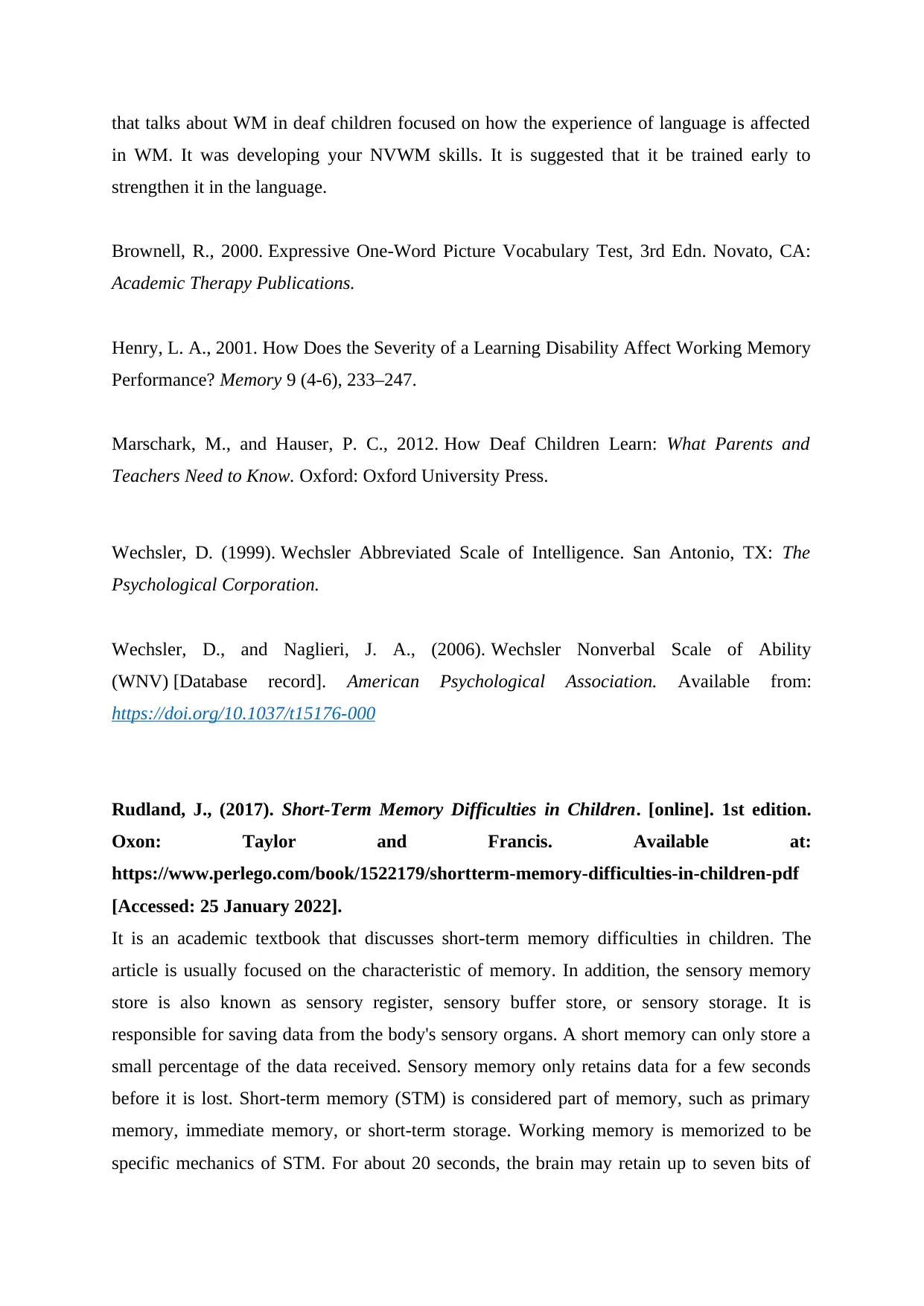
that talks about WM in deaf children focused on how the experience of language is affected
in WM. It was developing your NVWM skills. It is suggested that it be trained early to
strengthen it in the language.
Brownell, R., 2000. Expressive One-Word Picture Vocabulary Test, 3rd Edn. Novato, CA:
Academic Therapy Publications.
Henry, L. A., 2001. How Does the Severity of a Learning Disability Affect Working Memory
Performance? Memory 9 (4-6), 233–247.
Marschark, M., and Hauser, P. C., 2012. How Deaf Children Learn: What Parents and
Teachers Need to Know. Oxford: Oxford University Press.
Wechsler, D. (1999). Wechsler Abbreviated Scale of Intelligence. San Antonio, TX: The
Psychological Corporation.
Wechsler, D., and Naglieri, J. A., (2006). Wechsler Nonverbal Scale of Ability
(WNV) [Database record]. American Psychological Association. Available from:
https://doi.org/10.1037/t15176-000
Rudland, J., (2017). Short-Term Memory Difficulties in Children. [online]. 1st edition.
Oxon: Taylor and Francis. Available at:
https://www.perlego.com/book/1522179/shortterm-memory-difficulties-in-children-pdf
[Accessed: 25 January 2022].
It is an academic textbook that discusses short-term memory difficulties in children. The
article is usually focused on the characteristic of memory. In addition, the sensory memory
store is also known as sensory register, sensory buffer store, or sensory storage. It is
responsible for saving data from the body's sensory organs. A short memory can only store a
small percentage of the data received. Sensory memory only retains data for a few seconds
before it is lost. Short-term memory (STM) is considered part of memory, such as primary
memory, immediate memory, or short-term storage. Working memory is memorized to be
specific mechanics of STM. For about 20 seconds, the brain may retain up to seven bits of
in WM. It was developing your NVWM skills. It is suggested that it be trained early to
strengthen it in the language.
Brownell, R., 2000. Expressive One-Word Picture Vocabulary Test, 3rd Edn. Novato, CA:
Academic Therapy Publications.
Henry, L. A., 2001. How Does the Severity of a Learning Disability Affect Working Memory
Performance? Memory 9 (4-6), 233–247.
Marschark, M., and Hauser, P. C., 2012. How Deaf Children Learn: What Parents and
Teachers Need to Know. Oxford: Oxford University Press.
Wechsler, D. (1999). Wechsler Abbreviated Scale of Intelligence. San Antonio, TX: The
Psychological Corporation.
Wechsler, D., and Naglieri, J. A., (2006). Wechsler Nonverbal Scale of Ability
(WNV) [Database record]. American Psychological Association. Available from:
https://doi.org/10.1037/t15176-000
Rudland, J., (2017). Short-Term Memory Difficulties in Children. [online]. 1st edition.
Oxon: Taylor and Francis. Available at:
https://www.perlego.com/book/1522179/shortterm-memory-difficulties-in-children-pdf
[Accessed: 25 January 2022].
It is an academic textbook that discusses short-term memory difficulties in children. The
article is usually focused on the characteristic of memory. In addition, the sensory memory
store is also known as sensory register, sensory buffer store, or sensory storage. It is
responsible for saving data from the body's sensory organs. A short memory can only store a
small percentage of the data received. Sensory memory only retains data for a few seconds
before it is lost. Short-term memory (STM) is considered part of memory, such as primary
memory, immediate memory, or short-term storage. Working memory is memorized to be
specific mechanics of STM. For about 20 seconds, the brain may retain up to seven bits of
⊘ This is a preview!⊘
Do you want full access?
Subscribe today to unlock all pages.

Trusted by 1+ million students worldwide
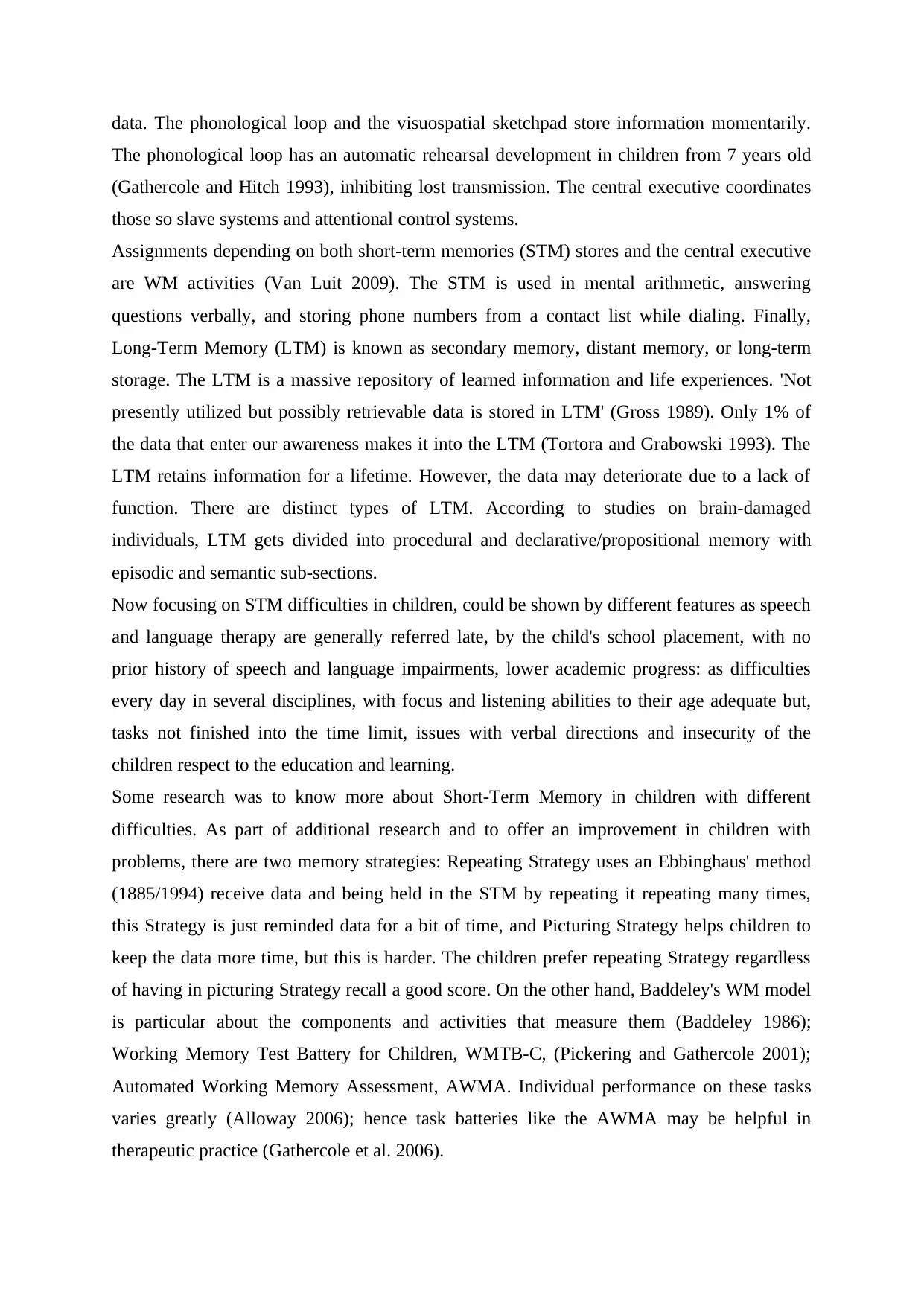
data. The phonological loop and the visuospatial sketchpad store information momentarily.
The phonological loop has an automatic rehearsal development in children from 7 years old
(Gathercole and Hitch 1993), inhibiting lost transmission. The central executive coordinates
those so slave systems and attentional control systems.
Assignments depending on both short-term memories (STM) stores and the central executive
are WM activities (Van Luit 2009). The STM is used in mental arithmetic, answering
questions verbally, and storing phone numbers from a contact list while dialing. Finally,
Long-Term Memory (LTM) is known as secondary memory, distant memory, or long-term
storage. The LTM is a massive repository of learned information and life experiences. 'Not
presently utilized but possibly retrievable data is stored in LTM' (Gross 1989). Only 1% of
the data that enter our awareness makes it into the LTM (Tortora and Grabowski 1993). The
LTM retains information for a lifetime. However, the data may deteriorate due to a lack of
function. There are distinct types of LTM. According to studies on brain-damaged
individuals, LTM gets divided into procedural and declarative/propositional memory with
episodic and semantic sub-sections.
Now focusing on STM difficulties in children, could be shown by different features as speech
and language therapy are generally referred late, by the child's school placement, with no
prior history of speech and language impairments, lower academic progress: as difficulties
every day in several disciplines, with focus and listening abilities to their age adequate but,
tasks not finished into the time limit, issues with verbal directions and insecurity of the
children respect to the education and learning.
Some research was to know more about Short-Term Memory in children with different
difficulties. As part of additional research and to offer an improvement in children with
problems, there are two memory strategies: Repeating Strategy uses an Ebbinghaus' method
(1885/1994) receive data and being held in the STM by repeating it repeating many times,
this Strategy is just reminded data for a bit of time, and Picturing Strategy helps children to
keep the data more time, but this is harder. The children prefer repeating Strategy regardless
of having in picturing Strategy recall a good score. On the other hand, Baddeley's WM model
is particular about the components and activities that measure them (Baddeley 1986);
Working Memory Test Battery for Children, WMTB-C, (Pickering and Gathercole 2001);
Automated Working Memory Assessment, AWMA. Individual performance on these tasks
varies greatly (Alloway 2006); hence task batteries like the AWMA may be helpful in
therapeutic practice (Gathercole et al. 2006).
The phonological loop has an automatic rehearsal development in children from 7 years old
(Gathercole and Hitch 1993), inhibiting lost transmission. The central executive coordinates
those so slave systems and attentional control systems.
Assignments depending on both short-term memories (STM) stores and the central executive
are WM activities (Van Luit 2009). The STM is used in mental arithmetic, answering
questions verbally, and storing phone numbers from a contact list while dialing. Finally,
Long-Term Memory (LTM) is known as secondary memory, distant memory, or long-term
storage. The LTM is a massive repository of learned information and life experiences. 'Not
presently utilized but possibly retrievable data is stored in LTM' (Gross 1989). Only 1% of
the data that enter our awareness makes it into the LTM (Tortora and Grabowski 1993). The
LTM retains information for a lifetime. However, the data may deteriorate due to a lack of
function. There are distinct types of LTM. According to studies on brain-damaged
individuals, LTM gets divided into procedural and declarative/propositional memory with
episodic and semantic sub-sections.
Now focusing on STM difficulties in children, could be shown by different features as speech
and language therapy are generally referred late, by the child's school placement, with no
prior history of speech and language impairments, lower academic progress: as difficulties
every day in several disciplines, with focus and listening abilities to their age adequate but,
tasks not finished into the time limit, issues with verbal directions and insecurity of the
children respect to the education and learning.
Some research was to know more about Short-Term Memory in children with different
difficulties. As part of additional research and to offer an improvement in children with
problems, there are two memory strategies: Repeating Strategy uses an Ebbinghaus' method
(1885/1994) receive data and being held in the STM by repeating it repeating many times,
this Strategy is just reminded data for a bit of time, and Picturing Strategy helps children to
keep the data more time, but this is harder. The children prefer repeating Strategy regardless
of having in picturing Strategy recall a good score. On the other hand, Baddeley's WM model
is particular about the components and activities that measure them (Baddeley 1986);
Working Memory Test Battery for Children, WMTB-C, (Pickering and Gathercole 2001);
Automated Working Memory Assessment, AWMA. Individual performance on these tasks
varies greatly (Alloway 2006); hence task batteries like the AWMA may be helpful in
therapeutic practice (Gathercole et al. 2006).
Paraphrase This Document
Need a fresh take? Get an instant paraphrase of this document with our AI Paraphraser
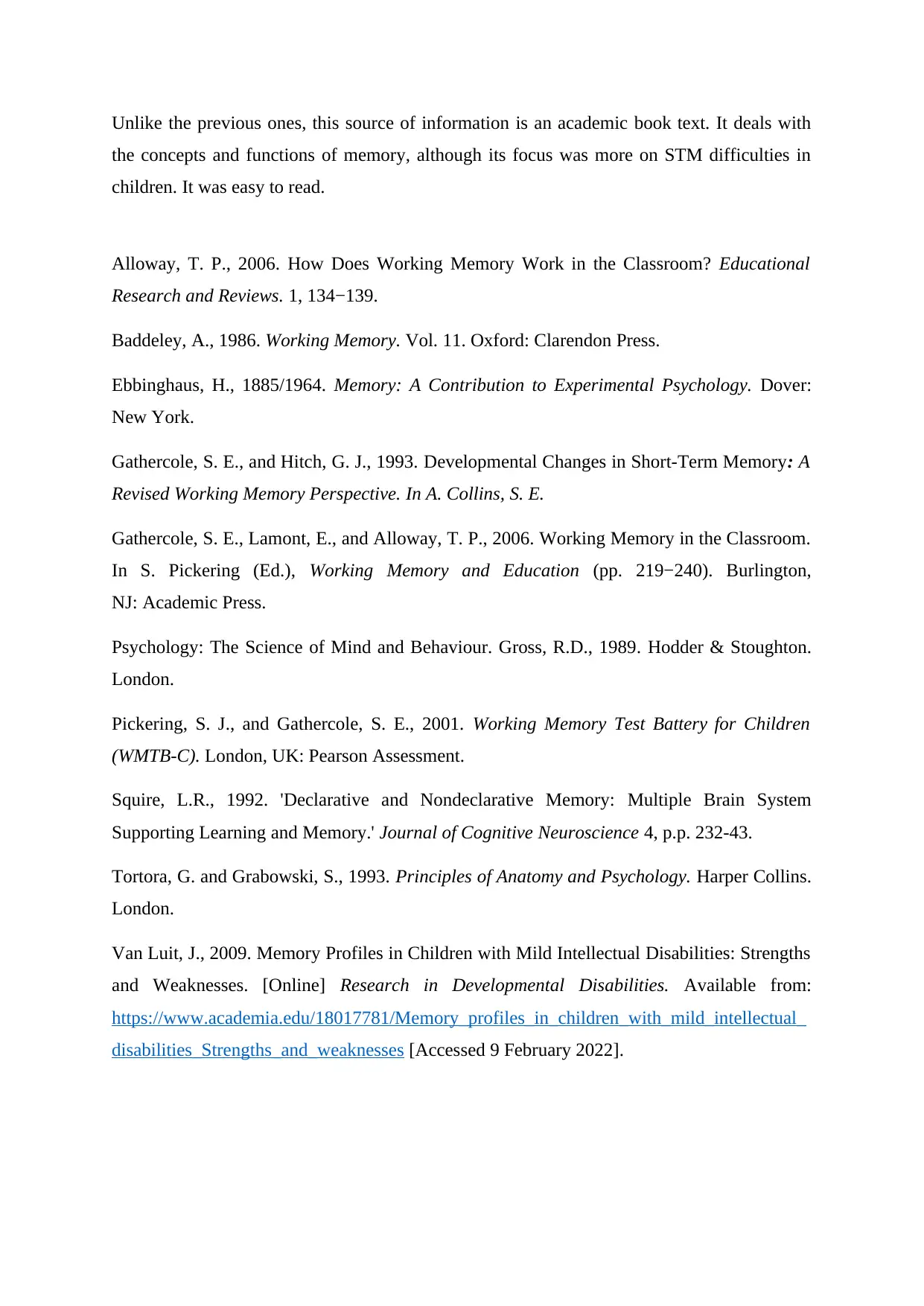
Unlike the previous ones, this source of information is an academic book text. It deals with
the concepts and functions of memory, although its focus was more on STM difficulties in
children. It was easy to read.
Alloway, T. P., 2006. How Does Working Memory Work in the Classroom? Educational
Research and Reviews. 1, 134−139.
Baddeley, A., 1986. Working Memory. Vol. 11. Oxford: Clarendon Press.
Ebbinghaus, H., 1885/1964. Memory: A Contribution to Experimental Psychology. Dover:
New York.
Gathercole, S. E., and Hitch, G. J., 1993. Developmental Changes in Short-Term Memory: A
Revised Working Memory Perspective. In A. Collins, S. E.
Gathercole, S. E., Lamont, E., and Alloway, T. P., 2006. Working Memory in the Classroom.
In S. Pickering (Ed.), Working Memory and Education (pp. 219−240). Burlington,
NJ: Academic Press.
Psychology: The Science of Mind and Behaviour. Gross, R.D., 1989. Hodder & Stoughton.
London.
Pickering, S. J., and Gathercole, S. E., 2001. Working Memory Test Battery for Children
(WMTB-C). London, UK: Pearson Assessment.
Squire, L.R., 1992. 'Declarative and Nondeclarative Memory: Multiple Brain System
Supporting Learning and Memory.' Journal of Cognitive Neuroscience 4, p.p. 232-43.
Tortora, G. and Grabowski, S., 1993. Principles of Anatomy and Psychology. Harper Collins.
London.
Van Luit, J., 2009. Memory Profiles in Children with Mild Intellectual Disabilities: Strengths
and Weaknesses. [Online] Research in Developmental Disabilities. Available from:
https://www.academia.edu/18017781/Memory_profiles_in_children_with_mild_intellectual_
disabilities_Strengths_and_weaknesses [Accessed 9 February 2022].
the concepts and functions of memory, although its focus was more on STM difficulties in
children. It was easy to read.
Alloway, T. P., 2006. How Does Working Memory Work in the Classroom? Educational
Research and Reviews. 1, 134−139.
Baddeley, A., 1986. Working Memory. Vol. 11. Oxford: Clarendon Press.
Ebbinghaus, H., 1885/1964. Memory: A Contribution to Experimental Psychology. Dover:
New York.
Gathercole, S. E., and Hitch, G. J., 1993. Developmental Changes in Short-Term Memory: A
Revised Working Memory Perspective. In A. Collins, S. E.
Gathercole, S. E., Lamont, E., and Alloway, T. P., 2006. Working Memory in the Classroom.
In S. Pickering (Ed.), Working Memory and Education (pp. 219−240). Burlington,
NJ: Academic Press.
Psychology: The Science of Mind and Behaviour. Gross, R.D., 1989. Hodder & Stoughton.
London.
Pickering, S. J., and Gathercole, S. E., 2001. Working Memory Test Battery for Children
(WMTB-C). London, UK: Pearson Assessment.
Squire, L.R., 1992. 'Declarative and Nondeclarative Memory: Multiple Brain System
Supporting Learning and Memory.' Journal of Cognitive Neuroscience 4, p.p. 232-43.
Tortora, G. and Grabowski, S., 1993. Principles of Anatomy and Psychology. Harper Collins.
London.
Van Luit, J., 2009. Memory Profiles in Children with Mild Intellectual Disabilities: Strengths
and Weaknesses. [Online] Research in Developmental Disabilities. Available from:
https://www.academia.edu/18017781/Memory_profiles_in_children_with_mild_intellectual_
disabilities_Strengths_and_weaknesses [Accessed 9 February 2022].
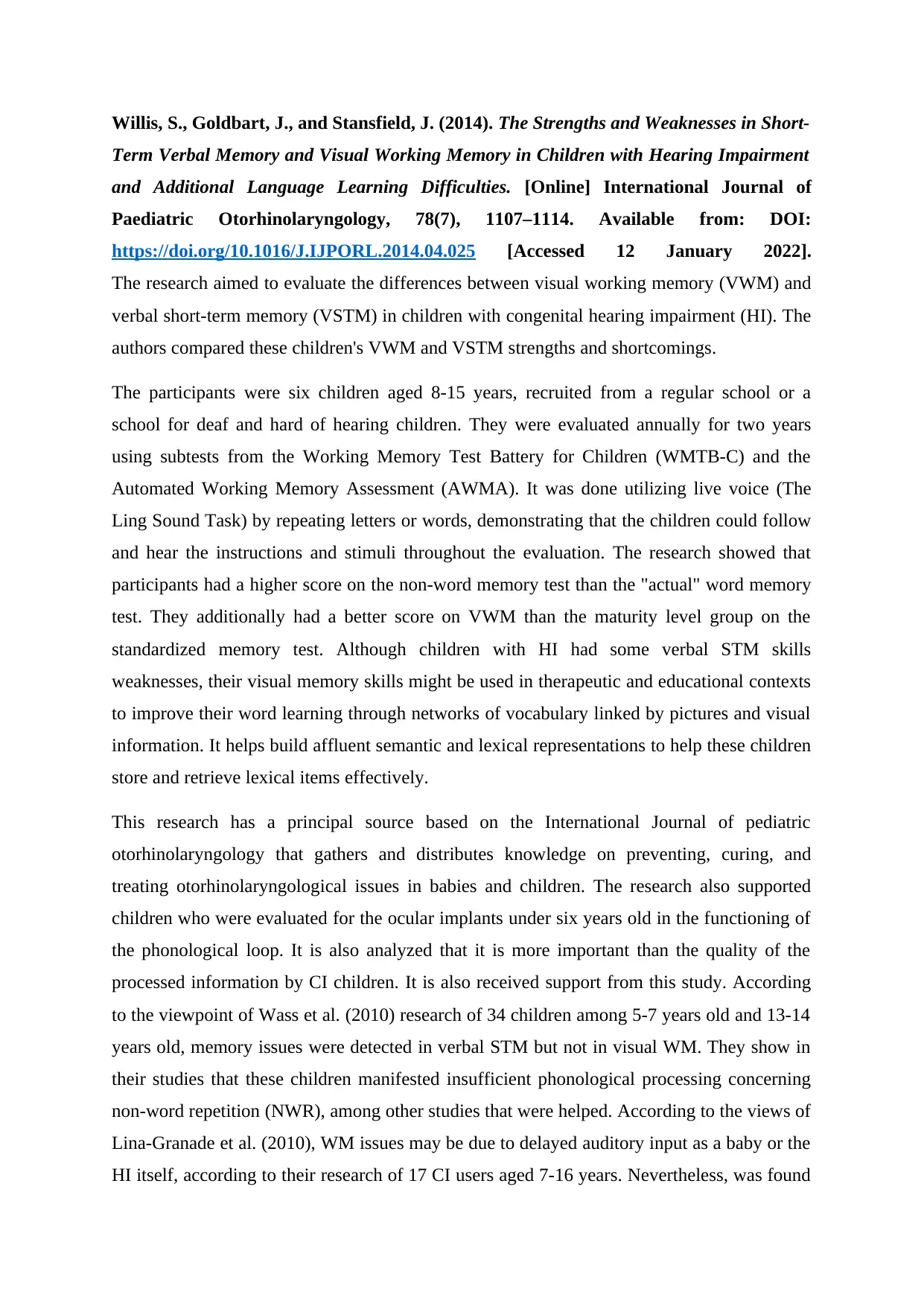
Willis, S., Goldbart, J., and Stansfield, J. (2014). The Strengths and Weaknesses in Short-
Term Verbal Memory and Visual Working Memory in Children with Hearing Impairment
and Additional Language Learning Difficulties. [Online] International Journal of
Paediatric Otorhinolaryngology, 78(7), 1107–1114. Available from: DOI:
https://doi.org/10.1016/J.IJPORL.2014.04.025 [Accessed 12 January 2022].
The research aimed to evaluate the differences between visual working memory (VWM) and
verbal short-term memory (VSTM) in children with congenital hearing impairment (HI). The
authors compared these children's VWM and VSTM strengths and shortcomings.
The participants were six children aged 8-15 years, recruited from a regular school or a
school for deaf and hard of hearing children. They were evaluated annually for two years
using subtests from the Working Memory Test Battery for Children (WMTB-C) and the
Automated Working Memory Assessment (AWMA). It was done utilizing live voice (The
Ling Sound Task) by repeating letters or words, demonstrating that the children could follow
and hear the instructions and stimuli throughout the evaluation. The research showed that
participants had a higher score on the non-word memory test than the "actual" word memory
test. They additionally had a better score on VWM than the maturity level group on the
standardized memory test. Although children with HI had some verbal STM skills
weaknesses, their visual memory skills might be used in therapeutic and educational contexts
to improve their word learning through networks of vocabulary linked by pictures and visual
information. It helps build affluent semantic and lexical representations to help these children
store and retrieve lexical items effectively.
This research has a principal source based on the International Journal of pediatric
otorhinolaryngology that gathers and distributes knowledge on preventing, curing, and
treating otorhinolaryngological issues in babies and children. The research also supported
children who were evaluated for the ocular implants under six years old in the functioning of
the phonological loop. It is also analyzed that it is more important than the quality of the
processed information by CI children. It is also received support from this study. According
to the viewpoint of Wass et al. (2010) research of 34 children among 5-7 years old and 13-14
years old, memory issues were detected in verbal STM but not in visual WM. They show in
their studies that these children manifested insufficient phonological processing concerning
non-word repetition (NWR), among other studies that were helped. According to the views of
Lina-Granade et al. (2010), WM issues may be due to delayed auditory input as a baby or the
HI itself, according to their research of 17 CI users aged 7-16 years. Nevertheless, was found
Term Verbal Memory and Visual Working Memory in Children with Hearing Impairment
and Additional Language Learning Difficulties. [Online] International Journal of
Paediatric Otorhinolaryngology, 78(7), 1107–1114. Available from: DOI:
https://doi.org/10.1016/J.IJPORL.2014.04.025 [Accessed 12 January 2022].
The research aimed to evaluate the differences between visual working memory (VWM) and
verbal short-term memory (VSTM) in children with congenital hearing impairment (HI). The
authors compared these children's VWM and VSTM strengths and shortcomings.
The participants were six children aged 8-15 years, recruited from a regular school or a
school for deaf and hard of hearing children. They were evaluated annually for two years
using subtests from the Working Memory Test Battery for Children (WMTB-C) and the
Automated Working Memory Assessment (AWMA). It was done utilizing live voice (The
Ling Sound Task) by repeating letters or words, demonstrating that the children could follow
and hear the instructions and stimuli throughout the evaluation. The research showed that
participants had a higher score on the non-word memory test than the "actual" word memory
test. They additionally had a better score on VWM than the maturity level group on the
standardized memory test. Although children with HI had some verbal STM skills
weaknesses, their visual memory skills might be used in therapeutic and educational contexts
to improve their word learning through networks of vocabulary linked by pictures and visual
information. It helps build affluent semantic and lexical representations to help these children
store and retrieve lexical items effectively.
This research has a principal source based on the International Journal of pediatric
otorhinolaryngology that gathers and distributes knowledge on preventing, curing, and
treating otorhinolaryngological issues in babies and children. The research also supported
children who were evaluated for the ocular implants under six years old in the functioning of
the phonological loop. It is also analyzed that it is more important than the quality of the
processed information by CI children. It is also received support from this study. According
to the viewpoint of Wass et al. (2010) research of 34 children among 5-7 years old and 13-14
years old, memory issues were detected in verbal STM but not in visual WM. They show in
their studies that these children manifested insufficient phonological processing concerning
non-word repetition (NWR), among other studies that were helped. According to the views of
Lina-Granade et al. (2010), WM issues may be due to delayed auditory input as a baby or the
HI itself, according to their research of 17 CI users aged 7-16 years. Nevertheless, was found
⊘ This is a preview!⊘
Do you want full access?
Subscribe today to unlock all pages.

Trusted by 1+ million students worldwide
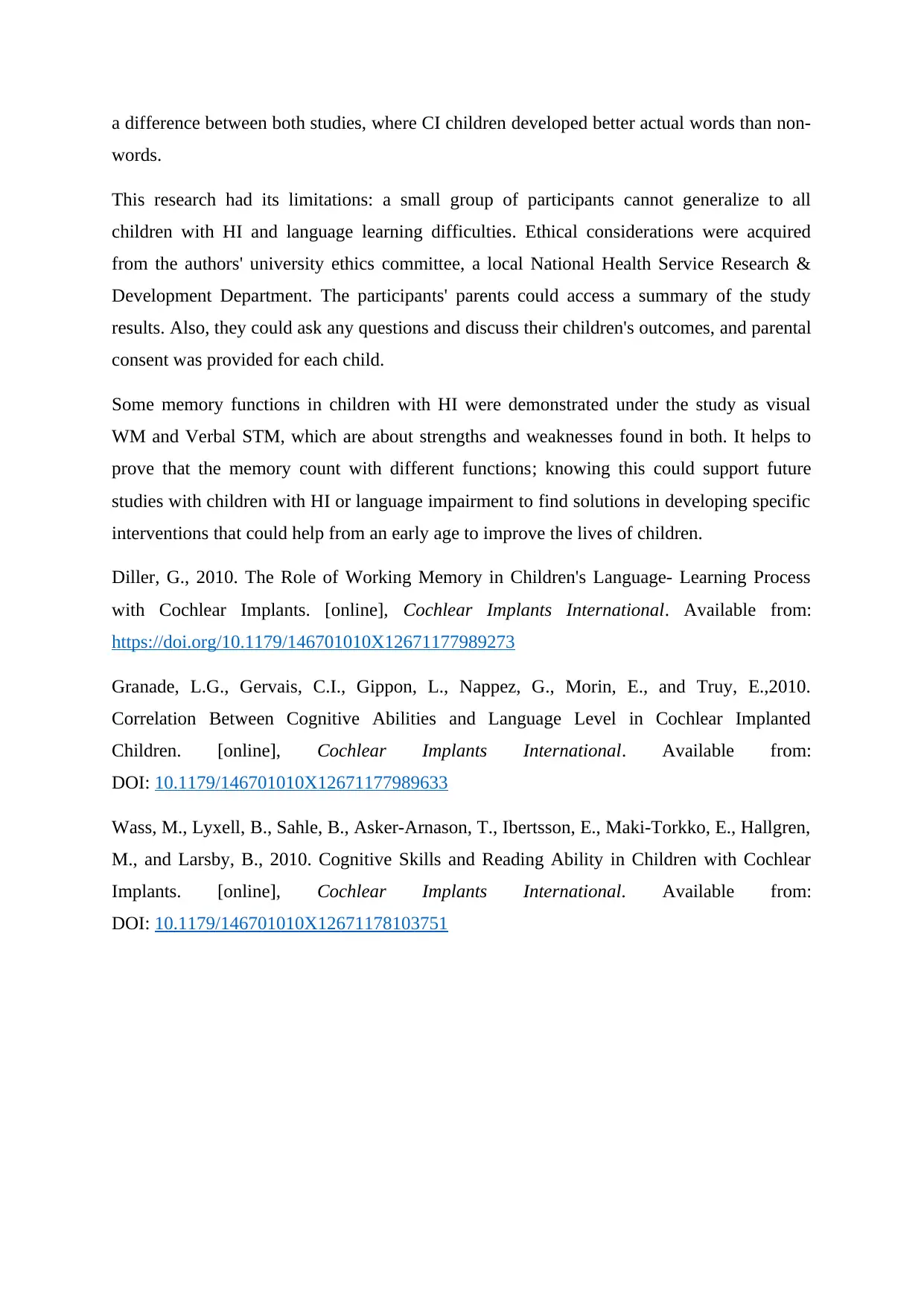
a difference between both studies, where CI children developed better actual words than non-
words.
This research had its limitations: a small group of participants cannot generalize to all
children with HI and language learning difficulties. Ethical considerations were acquired
from the authors' university ethics committee, a local National Health Service Research &
Development Department. The participants' parents could access a summary of the study
results. Also, they could ask any questions and discuss their children's outcomes, and parental
consent was provided for each child.
Some memory functions in children with HI were demonstrated under the study as visual
WM and Verbal STM, which are about strengths and weaknesses found in both. It helps to
prove that the memory count with different functions; knowing this could support future
studies with children with HI or language impairment to find solutions in developing specific
interventions that could help from an early age to improve the lives of children.
Diller, G., 2010. The Role of Working Memory in Children's Language- Learning Process
with Cochlear Implants. [online], Cochlear Implants International. Available from:
https://doi.org/10.1179/146701010X12671177989273
Granade, L.G., Gervais, C.I., Gippon, L., Nappez, G., Morin, E., and Truy, E.,2010.
Correlation Between Cognitive Abilities and Language Level in Cochlear Implanted
Children. [online], Cochlear Implants International. Available from:
DOI: 10.1179/146701010X12671177989633
Wass, M., Lyxell, B., Sahle, B., Asker-Arnason, T., Ibertsson, E., Maki-Torkko, E., Hallgren,
M., and Larsby, B., 2010. Cognitive Skills and Reading Ability in Children with Cochlear
Implants. [online], Cochlear Implants International. Available from:
DOI: 10.1179/146701010X12671178103751
words.
This research had its limitations: a small group of participants cannot generalize to all
children with HI and language learning difficulties. Ethical considerations were acquired
from the authors' university ethics committee, a local National Health Service Research &
Development Department. The participants' parents could access a summary of the study
results. Also, they could ask any questions and discuss their children's outcomes, and parental
consent was provided for each child.
Some memory functions in children with HI were demonstrated under the study as visual
WM and Verbal STM, which are about strengths and weaknesses found in both. It helps to
prove that the memory count with different functions; knowing this could support future
studies with children with HI or language impairment to find solutions in developing specific
interventions that could help from an early age to improve the lives of children.
Diller, G., 2010. The Role of Working Memory in Children's Language- Learning Process
with Cochlear Implants. [online], Cochlear Implants International. Available from:
https://doi.org/10.1179/146701010X12671177989273
Granade, L.G., Gervais, C.I., Gippon, L., Nappez, G., Morin, E., and Truy, E.,2010.
Correlation Between Cognitive Abilities and Language Level in Cochlear Implanted
Children. [online], Cochlear Implants International. Available from:
DOI: 10.1179/146701010X12671177989633
Wass, M., Lyxell, B., Sahle, B., Asker-Arnason, T., Ibertsson, E., Maki-Torkko, E., Hallgren,
M., and Larsby, B., 2010. Cognitive Skills and Reading Ability in Children with Cochlear
Implants. [online], Cochlear Implants International. Available from:
DOI: 10.1179/146701010X12671178103751
Paraphrase This Document
Need a fresh take? Get an instant paraphrase of this document with our AI Paraphraser

1 out of 11
Related Documents
Your All-in-One AI-Powered Toolkit for Academic Success.
+13062052269
info@desklib.com
Available 24*7 on WhatsApp / Email
![[object Object]](/_next/static/media/star-bottom.7253800d.svg)
Unlock your academic potential
Copyright © 2020–2025 A2Z Services. All Rights Reserved. Developed and managed by ZUCOL.





